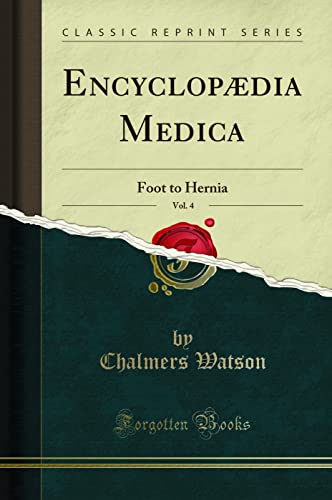Items related to Encyclopędia Medica, Vol. 4: Foot to Hernia (Classic...

The number of cases recorded in the human subject probably falls far short of representing the actual figures, on account of the difficulty in many instances of making a correct diagnosis. The first case was recorded in 1695. Since then many epidemics have occurred in different countries, and more especially between 1862 and 1869 in this country, though even in 1884 over two hundred persons suffered from the disease in Dover. In Germany, a large number of cases are still recorded each year.
Etiology. - The virus is contained in the saliva, the milk, urine, fӕces, and skin secretions, and retains its vitality for months, even for a year. Since the secretions and dejections are infective, it has been observed that the disease spreads along the great trade routes from the east of Europe to the west, and along the railway trunk lines, healthy animals being contaminated by the cattle-trucks, stubbles, pastures, and byres that have sheltered the diseased, and by manure, litter, fodder that have been soiled by the infective secretions. The disease is also spread by the attendants upon the animals, milkers, cattle and sheep dealers, and others brought in contact with healthy stock, after having handled those suffering from foot and mouth disease. It is known that birds suffer from the disease, and these may assist in spreading the disease.
The bacteria which have been found in connection with the disease possess merely an historic interest, and none of them represent the specific causal agent, which has not yet been discovered. Numerous bacteria have been found mainly in the vesicles: "Micrococcus aphtharum" (Rivolta and Nosotti), streptococci (Klein), "Streptococcus involutus" (Kurth), and pleomorphic bacteria (Stutzer and Hartleb, van Niessen). The Streptococcus involutus appears to be a normal inhabitant of the mouth of cattle (Sanfelice). A bacillus was obtained by Bussenius and Siegel, chiefly from affected animals, but also from the human subject, in fatal cases. The bacillus somewhat resembles the members of the Coli group, and Siegel has lately admitted that it is not the specific agent. Furtuna and Starcovici, Sauer, and Babes and Proca have also described bacteria in relation to the disease. Bodies resembling protozoa were found by Schottelius, Behla, Piana and Fiorenti, and Jungers, but these bodies are probably not true protozoa, and no etiological significance is to be attached to them. The Report published in 1897-98 of the German Commission which investigated the disease, shows that as a rule no microorganisms can be detected in fresh vesicles, but if the vesicles are several days old, various bacteria have usually gained entrance into their interior.
The specific virus is chiefly contained in the lymph of the vesicles. The blood serum does not seem to be infective after the local signs of the disease have appeared. Lymph which has been mixed with water and then passed through an unglazed porcelain filter is found to be infective. Hence the filtered lymph must either contain a toxine, which is poisonous in such a degree of dilution (1/750000000) as is hardly credible, or else the supposed micro-organism is so small that it can pass through the pores of the filter. The latter is the more probable explanation, for it has been shown that the disease can be transmitted from one animal to another in succession by means of such filtered lymph. Another point in favour of the virus being a corpuscular substance, is the fact that diluted lymph which has been repeatedly passed through a Kitasato filter loses its virulence (Loeffler and Frosch). Lymph retains its infective power for weeks or months under ordinary conditions, but loses it if exposed to a temperature of 70°C for half an hour, or to 60°C. for one hour.
Experimental Infection. - Calves and cattle are the animals most susceptible to infection, pigs being less so. The most r.
"synopsis" may belong to another edition of this title.
- PublisherForgotten Books
- Publication date2020
- ISBN 10 133117418X
- ISBN 13 9781331174189
- BindingPaperback
- Number of pages544
Buy New
Learn more about this copy
Shipping:
US$ 5.16
From United Kingdom to U.S.A.
Top Search Results from the AbeBooks Marketplace
EncyclopƦdia Medica, Vol. 4: Foot to Hernia (Classic Reprint)
Book Description Paperback. Condition: New. Print on Demand. Excerpt from EncyclopƦdia Medica. About the Publisher, Forgotten Books publishes hundreds of thousands of rare and classic books. This book is a reproduction of an important historical work. Forgotten Books uses state-of-the-art technology to digitally reconstruct the work, preserving the original format whilst repairing imperfections present in the aged copy. In rare cases, an imperfection in the original, such as a blemish or missing page, may be replicated in our edition. We do, however, repair the vast majority of imperfections successfully; any imperfections that remain are intentionally left to preserve the state of such historical works. This text has been digitally restored from a historical edition. Some errors may persist, however we consider it worth publishing due to the work's historical value. The digital edition of all books may be viewed on our website before purchase. print-on-demand item. Seller Inventory # 9781331174189_0
Encyclopdia Medica, Vol 4 Foot to Hernia Classic Reprint
Book Description PAP. Condition: New. New Book. Shipped from UK. Established seller since 2000. Seller Inventory # LW-9781331174189
Encyclopdia Medica, Vol 4 Foot to Hernia Classic Reprint
Book Description PAP. Condition: New. New Book. Shipped from UK. Established seller since 2000. Seller Inventory # LW-9781331174189

